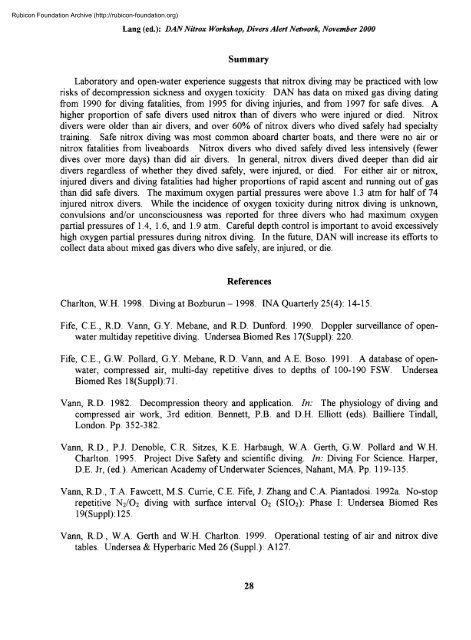Nitrox workshop dings - Divers Alert Network
Nitrox workshop dings - Divers Alert Network
Nitrox workshop dings - Divers Alert Network
Create successful ePaper yourself
Turn your PDF publications into a flip-book with our unique Google optimized e-Paper software.
Rubicon Foundation Archive (http://rubicon-foundation.org)Lang (ed.): DAN <strong>Nitrox</strong> Workshop, <strong>Divers</strong> <strong>Alert</strong> <strong>Network</strong>, November 2000SummaryLaboratory and open-water experience suggests that nitrox diving may be practiced with lowrisks of decompression sickness and oxygen toxicity. DAN has data on mixed gas diving datingfrom 1990 for diving fatalities, from 1995 for diving injuries, and from 1997 for safe dives. Ahigher proportion of safe divers used nitrox than of divers who were injured or died. <strong>Nitrox</strong>divers were older than air divers, and over 60% of nitrox divers who dived safely had specialtytraining. Safe nitrox diving was most common aboard charter boats, and there were no air ornitrox fatalities from liveaboards. <strong>Nitrox</strong> divers who dived safely dived less intensively (fewerdives over more days) than did air divers. In general, nitrox divers dived deeper than did airdivers regardless of whether they dived safely, were injured, or died. For either air or nitrox,injured divers and diving fatalities had higher proportions of rapid ascent and running out of gasthan did safe divers. The maximum oxygen partial pressures were above 1.3 atm for half of 74injured nitrox divers. While the incidence of oxygen toxicity during nitrox diving is unknown,convulsions and/or unconsciousness was reported for three divers who had maximum oxygenpartial pressures of 1.4, 1.6, and 1.9 atm. Careful depth control is important to avoid excessivelyhigh oxygen partial pressures during nitrox diving. In the future, DAN will increase its efforts tocollect data about mixed gas divers who dive safely, are injured, or die.ReferencesCharlton, W.H. 1998. Diving at Bozburun-1998. INA Quarterly 25(4): 14-15.Fife, C.E., R.D. Vann, G.Y. Mebane, and R.D. Dunford. 1990. Doppler surveillance of openwatermultiday repetitive diving. Undersea Biomed Res 17(Suppl): 220.Fife, C.E., G.W. Pollard, G.Y. Mebane, R.D. Vann, and A.E. Boso. 1991. A database of openwater,compressed air, multi-day repetitive dives to depths of 100-190 FSW. UnderseaBiomed Res 18(Suppl):71.Vann, R.D. 1982. Decompression theory and application. In: The physiology of diving andcompressed air work, 3rd edition. Bennett, P.B. and D.H. Elliott (eds). Bailliere Tindall,London. Pp. 352-382.Vann, R.D., P.J. Denoble, C.R. Sitzes, K.E. Harbaugh, W.A. Gerth, G.W. Pollard and W.H.Charlton. 1995. Project Dive Safety and scientific diving. In: Diving For Science. Harper,D.E. Jr, (ed.). American Academy of Underwater Sciences, Nahant, MA. Pp. 119-135.Vann, R.D., T.A. Fawcett, M.S. Currie, C.E. Fife, J. Zhang and C.A. Piantadosi. 1992a. No-stoprepetitive N2/O2 diving with surface interval O2 (SIO2): Phase I: Undersea Biomed Res19(Suppl):125.Vann, R.D., W.A. Gerth and W.H. Charlton. 1999. Operational testing of air and nitrox divetables. Undersea & Hyperbaric Med 26 (Suppl.): A127.28
















